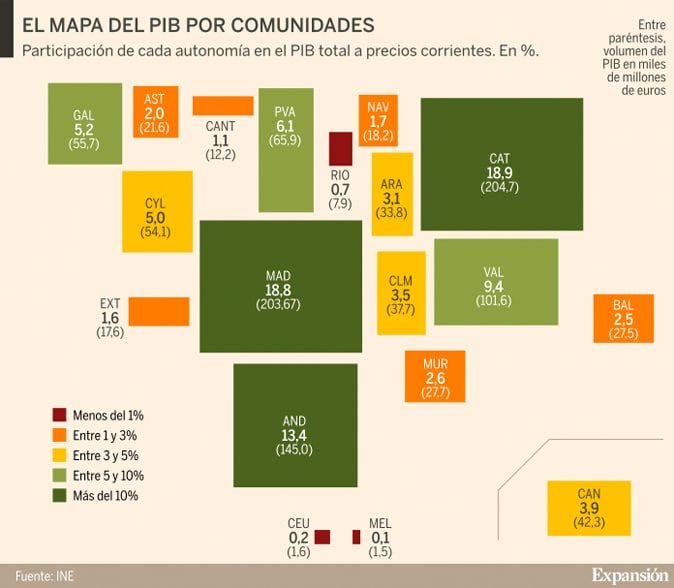It should come as no surprise that Spanish salaries are on average 20% to 30% lower than those in France. The standard of living of Spanish citizens is therefore lower on average, and living in Spain is therefore less expensive overall. It’s important to remember, however, that this is only an average. In fact, the difference in living standards between the two countries can be more or less significant, depending on age group, sector of activity and, above all, region.
With 204.7 million euros, Catalonia has the highest GDP in Spain, accounting for almost 19% of Spanish GDP. The capital, Madrid, has a GDP of 203.67 million euros, putting it in second place.
To get a better idea of the population’s standard of living, GDP per capita is more telling. The Basque Country is the leading community. Madrid is second and Navarre third. Catalonia is fourth in terms of GDP per capita. Conversely, Andalusia has a GDP per capita almost 2 times lower than that of the Basque Country! These statistics given by theExpansion website in 2016 clearly show the wealth disparities between Spain’s communities.

Although the minimum wage in Spain has been on the rise since the early 2000s, the economic crisis of 2008 slowed this progression. In fact, according to Eurostat, since 2010, the minimum wage in Spain has been around €750 per month. Moreover, according to Adecco, the average wage is 17.8% below the European average. According to this 2016 study, the average Spanish salary is €1,640 gross per month. By way of comparison, the average gross monthly salary for all 28 member countries of the European Union is €1995. This is lower than the French average of €2,255 gross per month. However, these figures need to be put into perspective. As the cost of living is generally lower, the gap with France is not so great.
Unlike France, where the law obliges a company to pay an intern for more than 2 months (554€), in Spain there is no obligation to pay an intern. However, all internships in Spain offered by Stud&Globe are paid.
Despite a rise in house prices of almost 5% in 2016, property prices in Spain remain on average 2 times lower than in France. But make no mistake, there are significant price differences between the country’s communities, provinces and cities. For example, in 2016, house prices in Madrid rose by over 8%, in Catalonia by 7% and in the Balearic Islands by 6.2%. This explosion in prices is testimony to Spain’s economic recovery (GDP grew by 3.2% in 2016).
If we’re talking about the cost of everyday living, it’s also lower in Spain. In fact, whether it’s fruit and vegetables or supermarket essentials, prices are lower. This difference can be felt, for example, in the total cost of a full shopping trip.
The opposite is true for the price of communications. In Spain, prices for telephone and Internet packages are generally higher than those on the French market. This is mainly due to the low-cost offering in the Iberian Peninsula. However, competition between operators is fierce, and it’s important to compare all offers to find the best one for the best price. This applies to TV, internet, mobile and landline services.
When it comes to leisure and relaxation, Spain’s reputation is second to none! Whether it’s cinema, cultural offerings of all kinds (museums, parks, ruins…), nightlife or sports, the offers are very generous. Prices also vary from city to city, but are generally slightly lower than in France!
Generally speaking, the cost of living is lower in Spain. However, the standard of living is also lower than in France.
Horaires : 9h00 à 18h00 du lundi au dimanche

Depuis la France +33 1 87 65 28 12
Depuis l’Espagne +34 931 59 18 57
Opening hours: 9 a.m. to 6 p.m. Monday to Sunday

From France +33 1 87 65 28 12
From Spain +34 931 59 18 57
Opening hours: 9 a.m. to 6 p.m. Monday to Sunday

From France +33 1 87 65 28 12
From Spain +34 931 59 18 57